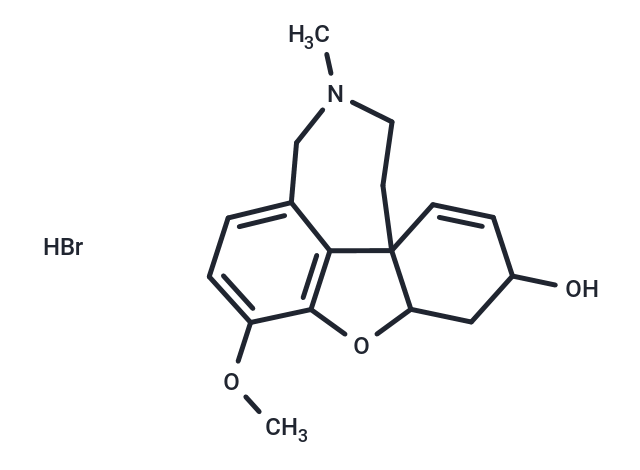Shopping Cart
Remove All Your shopping cart is currently empty
Your shopping cart is currently empty
Galanthamine hydrobromide (Galantamine hydrobromide), a long-acting and centrally active AChE inhibitor (IC50:410 nM), is an allosteric potentiator at neuronal nicotinic ACh receptors.

| Pack Size | Price | USA Warehouse | Global Warehouse | Quantity |
|---|---|---|---|---|
| 25 mg | $36 | In Stock | In Stock | |
| 50 mg | $52 | In Stock | In Stock | |
| 100 mg | $62 | In Stock | In Stock | |
| 500 mg | $176 | In Stock | In Stock | |
| 1 mL x 10 mM (in DMSO) | $57 | In Stock | In Stock |
| Description | Galanthamine hydrobromide (Galantamine hydrobromide), a long-acting and centrally active AChE inhibitor (IC50:410 nM), is an allosteric potentiator at neuronal nicotinic ACh receptors. |
| Targets&IC50 | AChE:410 nM |
| In vitro | Galanthamine has been demonstrated to have an IC50 of 14 nM and 15 nM on AChE in post-mortem human brain frontal cortex and the hippocampus region. Red-cell cholinesterase activity in blood samples from the neurosurgery patients is 10 times more strongly inhibited by Galanthamine in brain tissue samples. [1] Galanthamine (1 μM) activates single channels with conductance's of 18 and 30 pS in outside-out patches excised from dexamethasone mouse fibroblasts (M10 cells). [2] Galanthamine acts as noncompetitive nicotinic receptor agonists' on clonal rat pheochromocytoma (PC12) cells. Galanthamine (50 μM) activates single-channel currents in outside-out patches excised from clonal PC12 cells. [3] |
| In vivo | Galantamine significantly increases the number of living pyramidal neurons after ischemia-reperfusion injury. Galantamine significantly reduces TUNEL, active caspase-3, and SOD-2 immunoreactivity. The nicotinic antagonist mecamylamine blockes the protective effects of galantamine. The neuroprotective effects of galantamine are preserved even when first administered at 3 hours postischemia. [4] |
| Synonyms | Galanthamine HBr, Galantamine hydrobromide |
| Molecular Weight | 368.27 |
| Formula | C17H21NO3·HBr |
| Cas No. | 1953-04-4 |
| Smiles | Br.COc1ccc2CN(C)CCC34C=CC(O)CC3Oc1c24 |
| Relative Density. | no data available |
| Color | White |
| Appearance | Solid |
| Storage | Powder: -20°C for 3 years | In solvent: -80°C for 1 year | Shipping with blue ice/Shipping at ambient temperature. | ||||||||||||||||||||||||||||||||||||||||
| Solubility Information | DMSO: 60 mg/mL (162.92 mM), Heating is recommended. H2O: 7.4 mg/mL (20.09 mM), Sonication is recommended. | ||||||||||||||||||||||||||||||||||||||||
| In Vivo Formulation | 10% DMSO+40% PEG300+5% Tween 80+45% Saline: 1 mg/mL (2.72 mM), Sonication is recommended. Please add the solvents sequentially, clarifying the solution as much as possible before adding the next one. Dissolve by heating and/or sonication if necessary. Working solution is recommended to be prepared and used immediately. The formulation provided above is for reference purposes only. In vivo formulations may vary and should be modified based on specific experimental conditions. | ||||||||||||||||||||||||||||||||||||||||
Solution Preparation Table | |||||||||||||||||||||||||||||||||||||||||
H2O/DMSO
DMSO
| |||||||||||||||||||||||||||||||||||||||||
| Size | Quantity | Unit Price | Amount | Operation |
|---|

Copyright © 2015-2025 TargetMol Chemicals Inc. All Rights Reserved.